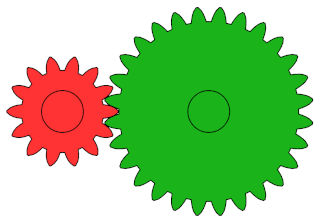
A gear is a rotating circular machine part having cut teeth or, in the case of a cogwheel or gearwheel, inserted teeth, which mesh with another (compatible) toothed part to transmit rotational power. While doing so, they can change the torque and rotational speed being transmitted and also change the rotational axis of the power being transmitted. The teeth on the two meshing gears all have the same shape.

A differential is a gear train with three drive shafts that has the property that the rotational speed of one shaft is the average of the speeds of the others. A common use of differentials is in motor vehicles, to allow the wheels at each end of a drive axle to rotate at different speeds while cornering. Other uses include clocks and analogue computers. Differentials can also provide a gear ratio between the input and output shafts. For example, many differentials in motor vehicles provide a gearing reduction by having fewer teeth on the pinion than the ring gear.
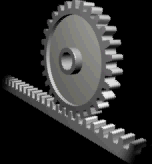
A rack and pinion is a type of linear actuator that comprises a circular gear engaging a linear gear. Together, they convert between rotational motion and linear motion. Rotating the pinion causes the rack to be driven in a line. Conversely, moving the rack linearly will cause the pinion to rotate. A rack-and-pinion drive can use both straight and helical gears. Though some suggest helical gears are quieter in operation, no hard evidence supports this theory. Helical racks, while being more affordable, have proven to increase side torque on the datums, increasing operating temperature leading to premature wear. Straight racks require a lower driving force and offer increased torque and speed per fraction of gear ratio which allows lower operating temperature and lessens viscal friction and energy use. The maximum force that can be transmitted in a rack-and-pinion mechanism is determined by the torque on the pinion and its size, or, conversely, by the force on the rack and the size of the pinion.
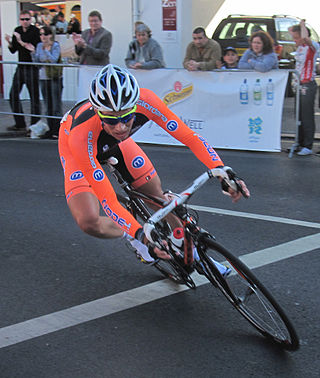
Steering is the control of the direction of motion or the components that enable its control. Steering is achieved through various arrangements, among them ailerons for airplanes, rudders for boats, tilting rotors for helicopters, and many more.

Hobbing is a machining process for gear cutting, cutting splines, and cutting sprockets using a hobbing machine, a specialized milling machine. The teeth or splines of the gear are progressively cut into the material by a series of cuts made by a cutting tool called a hob.
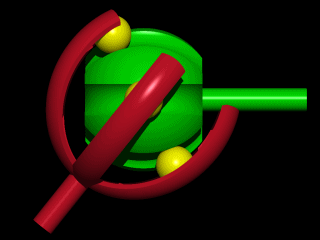
A constant-velocity joint is a mechanical coupling which allows the shafts to rotate freely and compensates for the angle between the two shafts, within a certain range, to maintain the same velocity.

TorqueFlite is the trademarked name of Chrysler Corporation's automatic transmissions, starting with the three-speed unit introduced late in the 1956 model year as a successor to Chrysler's two-speed PowerFlite. In the 1990s, the TorqueFlite name was dropped in favor of alphanumeric designations, although the latest Chrysler eight-speed automatic transmission has revived the name.

A Pitman arm is a shaft that translates rotary or angular movement into linear movement, or vice versa. Pitman arms are commonly found in water pumping windmills, automotive steering systems, and sewing machines.
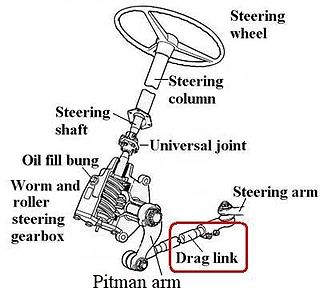
A drag link converts rotary motion from a crank arm, to a second bellcrank, usually in an automotive steering system.

A linear actuator is an actuator that creates linear motion, in contrast to the circular motion of a conventional electric motor. Linear actuators are used in machine tools and industrial machinery, in computer peripherals such as disk drives and printers, in valves and dampers, and in many other places where linear motion is required. Hydraulic or pneumatic cylinders inherently produce linear motion. Many other mechanisms are used to generate linear motion from a rotating motor.

A worm drive is a gear arrangement in which a worm meshes with a worm wheel. The two elements are also called the worm screw and worm gear. The terminology is often confused by imprecise use of the term worm gear to refer to the worm, the worm wheel, or the worm drive as a unit.

A ball screw is a mechanical linear actuator that translates rotational motion to linear motion with little friction. A threaded shaft provides a helical raceway for ball bearings which act as a precision screw. As well as being able to apply or withstand high thrust loads, they can do so with minimum internal friction. They are made to close tolerances and are therefore suitable for high-precision applications. The ball assembly acts as the nut while the threaded shaft is the screw.

The Crayford focuser is a simplified focusing mechanism for amateur astronomical telescopes. Crayford focusers are considered superior to entry-level rack and pinion focusers, normally found in this type of device. Instead of the rack and pinion, they have a smooth spring-loaded shaft which holds the focus tube against four opposing bearing surfaces, and controls its movement. It is named after the Crayford Manor House Astronomical Society, Crayford, London, England, where it was invented by John Wall, a member of the astronomical society which meets there. The original Crayford Focuser is on display there.
Active steering describes a steering system for a vehicle in which the relationship between the driver’s steer inputs and the angle of the steered road wheels may be continuously and intelligently altered. Whilst active steering systems may be found in agricultural equipment and heavy plant, this article concentrates on the application of active steering in BMW passenger cars.

In mechanical engineering, backlash, sometimes called lash, play, or slop, is a clearance or lost motion in a mechanism caused by gaps between the parts. It can be defined as "the maximum distance or angle through which any part of a mechanical system may be moved in one direction without applying appreciable force or motion to the next part in mechanical sequence."p. 1-8 An example, in the context of gears and gear trains, is the amount of clearance between mated gear teeth. It can be seen when the direction of movement is reversed and the slack or lost motion is taken up before the reversal of motion is complete. It can be heard from the railway couplings when a train reverses direction. Another example is in a valve train with mechanical tappets, where a certain range of lash is necessary for the valves to work properly.
The GM 10.5" 14-bolt differential stands as a robust drivetrain component extensively featured in Chevrolet and GMC trucks, SUVs, and vans from 1973 onward, including specific versions of the Cadillac Escalade. Introduced in 1973, this differential employs a full-floating design, boasting a substantial ring gear diameter measuring 10.5 inches. Its nomenclature, "14-bolt," represents the 14 bolts securing the differential cover, although the ring gear itself is fastened by 12 bolts. Notably, the 14-bolt differential gained traction among Jeep Wrangler owners seeking axle replacement options, earning the moniker "corporate" 14-bolt because of its association with GM's corporate structure during the 1970s.
Steering kickback relates to the sharp and rapid movements of an automobile's steering wheel as the front wheels encounter a significant obstruction or imperfection in the road. The amount of kickback is dependent on a variety of factors, namely the angle of impact with the obstruction or imperfection, health and stiffness of the vehicle's shock absorbers, and the speed of the vehicle, as well as the type of steering mechanism used and its mechanical advantage.
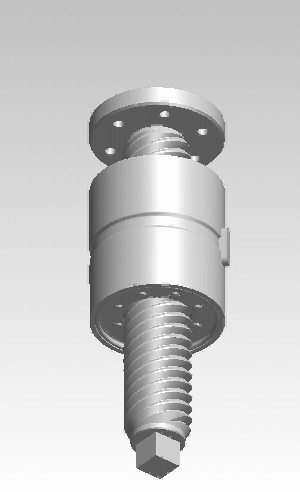
A roller screw, also known as a planetary roller screw or satellite roller screw, is a low-friction precision screw-type actuator, a mechanical device for converting rotational motion to linear motion, or vice versa. Planetary roller screws are used as the actuating mechanism in many electromechanical linear actuators. Due to its complexity, the roller screw is a relatively expensive actuator, but may be suitable for high-precision, high-speed, heavy-load, long-life, and heavy-use applications.
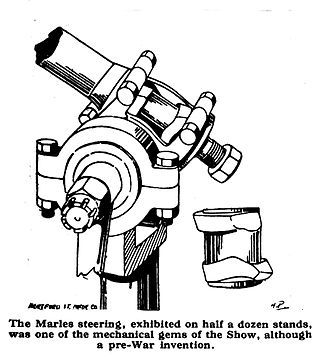
Marles steering gear was an hour-glass-and-roller steering gear for mechanically propelled vehicles invented by British inventor and businessman Henry Marles (1871-1955) who also gave his name to his joint-venture Ransome & Marles a major British ball-bearing manufacturer. Aside from ease of use Marles' steering's great appeal to drivers was its lack of backlash.
















